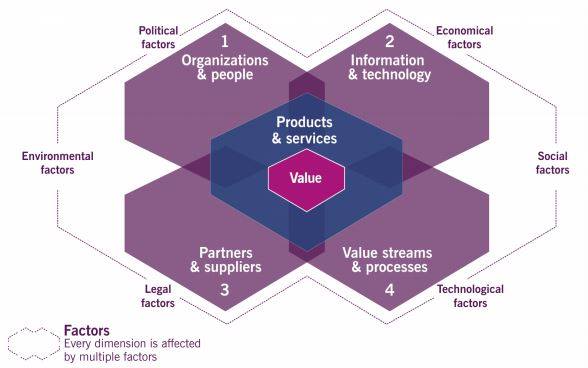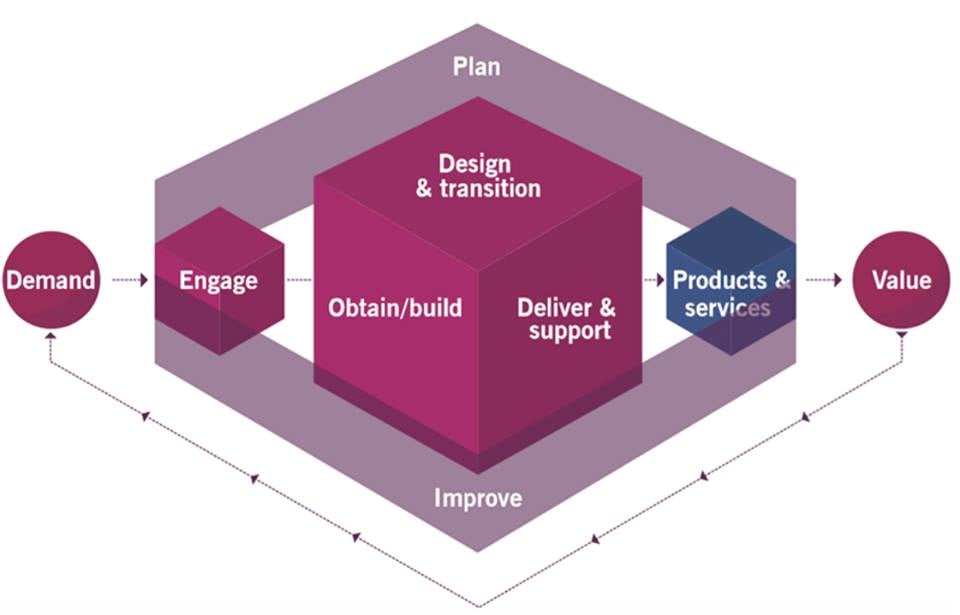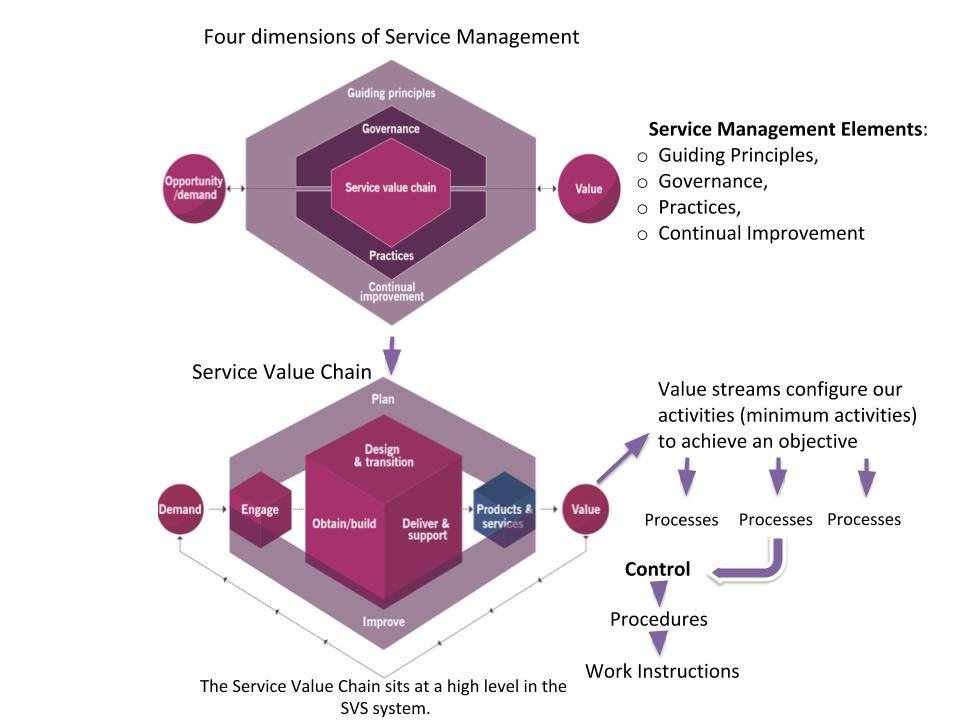ITIL 4: A new approach towards Organizational Agility
Organizational agility is the ability of the organizations to adapt to changes in their environment. All organizations need to be flexible, responsive, and adaptable in different areas. These include technology, competition, changes in the market, and more. For many IT professionals, agility refers to software development. It is associated with the Agile manifesto. Many organizations have adopted Agile software development methods. These methods have shown themselves to be very effective.
The principles of Agile, Lean, and DevOps are applied to many ITSM practices as a means to modernize the approaches taken. These approaches improve the ability of ITSM to deliver benefits while offering additional flexibility, which contributes to agility. As a result, organizational agility is an expansive concept where organizations must balance the need for stability and predictability with the increasing need for operational agility and velocity.
Agility is not fixed; it operates on a scale. It works on strategic, tactical and operational levels, at the same time. We can achieve agility by understanding the interrelation and interaction between
- Service Value System (SVS)
- Service value chains and
- Service value streams

The Service Value System
Copyright AXELOS limited 2018
The ITIL SVS describes service management as a system where the input is demand/opportunity, and the output is value.
The components include Guiding Principles, Governance, Service Value Chain, Practices, and Continual Improvement. The SVS enables the components and activities to work together as a system to create Value.
ITIL SVS takes the above definition of agility and applies it to the service lifecycle. In this way, agility becomes a quality. It is embedded within all service management dimensions and service value chain activities. Here's an introduction to the four dimensions of service management. This will provide a greater understanding of how it contributes to organizational agility.

The Four Dimensions of Service Management
Copyright AXELOS limited 2018
The four dimensions of service management are:
- Organizations & people
- Information & Technology
- Partners & Suppliers
- Value streams & processes
Customers receive services through the coordination and integration of the four dimensions. Agility is factored into each of the four dimensions. These dimensions provide end-to-end visibility on the parts of the organization working together. This helps with outcomes that provide value to both internal and external customers.
External factors as identified by the PESTLE framework are:
- Political
- Economic
- Social
- Technological
- Legal
- Environmental
These introduce levels of volatility and uncertainty and can be dealt with by reconfiguring resources to address the four dimensions. Agility is the ability to reconfigure resources and activities. It is based on the impact of the different factors on different aspects of the organization. External factors are actors in the larger ecosystem of which the organization is a part.
The dimensions enable agility by helping to breakdown organizational silos. This is where business units tend to design their processes, documentation, and systems. The processes or documentation is to address their specific areas of responsibility. It counters to the think and work approach, offered by the SVS. The system approach lends better understanding on the creation of parts of the organization. And how they act as a single integrated whole, rather than its constituent parts.
Organizational silos hinder communication and collaboration under organizational agility and resilience. This is across different groups. It reduces an organization’s ability to respond to opportunities or optimize resources. Which is due to their failure in completely understanding interfaces between various practices. Agility or being agile means understanding the key points within practices. The practices where information exchanges are critical.
To address this, the four dimensions make use of the central element of the SVS, the service value chain. This outlines the key activities in the form of value streams to transform inputs to outputs. The inputs may originate as demand from outside the chain. They may also originate as outputs from other activities.

The Service Value Chain
Identifying value streams contribute to organizational agility. This is by assisting organizations in examining how they perform work. It results in the identification of any barriers to workflow and pointless activities. The service value chain serves as an operating model. It outlines the key activities needed to ease the value.
The six value chain activities are:
- Plan
- Improve
- Engage
- Design & Transition
- Obtain/Build
- Deliver/Support
Here, the connection and interaction between activities express agility. Each activity receives and provides triggers for further actions.
Combining different sets of ITIL practices helps to convert inputs to outputs. These practices may involve internal or third-party resources, skills, and competencies. For this to work well, agility in processing feedback is imperative. It results in continued and fast improvement of IT services. Which is in response to stimuli from both internal and external factors.
Value streams are mapped to describe activity flow through the service value system. Depending on the situation, different value chain activities will be emphasized over others. That is, not all value chains ease equal value.
The value mapping activity can highlight which roles, practices, and events are optimal. This enhances the agility of the organization to coordinate its resources better. Every organization is different. Hence, the practices that better lend themselves to organizational agility may differ. Anyhow, as a general rule, enhancing organizational agility can be done for all. This can be done by using value stream mapping to optimize the following practices:
- Strategy Management
- Continual Improvement
- Change Control
- Risk Management and others (e.g., knowledge management practice)
The enabling of value creation is vital. Agile strategy management practice seeks to find a balance between innovation and control. While retaining enough flexibility in its approach to responding to changing circumstances.
Recall that ITIL SVS includes the continual improvement model. It applies to any type of improvement. It ranges from high-level organizational change to services to configuration items. The continual improvement practice interacts with every other practice.

Continual improvement occurs throughout the entire organization. At all levels, ranging from strategic to operational. Entire SVS can include products, services, service relationship, and more. Continual improvement is the embodiment of agility. The agility that remains focused on value, and which links back to the vision of the organization. It is an iterative approach and connotes the principal guiding progress with feedback. It allows course corrections, direction setting, circumstantial evidence for actions.
The continual improvement practice propagates across the organization. The embedding of this practice into the fabric of the organization enables agility. It prevents the organization from allowing operational activities. Also, prevents major project work from overtaking the strategic picture. It ensures the flow up, down and across all organization activities. It also aligns with evolving organizational objectives and outcomes.

Source: https://www.freepik.com/
The ability of an organization to change in response to external factors can make the difference between failure and success. It is an integral aspect of Lean, Agile, DevOps, and other frameworks. These frameworks assist in identifying weak areas in the value chain. Once identified, efforts can be made to mitigate these weak areas. And also to organize other steps in value chains around them. It includes the actions and activities of third parties. This is because they perform some of the activities within value streams.
An organization needs to be agile to innovate although innovation is inherently risky. Proper risk management enhances organizational agility. This helps an organization to achieve a balance. A balance where the benefit outweighs the cost of addressing risk. Here, agility expresses itself in the form of flexibility for different parts of the organization. This is to manage the risk in alignment with the organizational risk appetite which can change over time and circumstances.
Yet, it is important that risk management practices are managed. This is to be consistent across the organization. Based on the risk strategy, even different customer/user groups have specific needs.

The System to Stream Diagram
The above System to Stream diagram demonstrates how the SVS works from the macro to more granular levels of an organization. At a higher level, there are elements of the SVS:
- Guiding Principles
- Governance
- Service Value Chain
- Practices, and
- Continual Improvement
As an aide to this integration, the four dimensions offer organizations a holistic approach to IT service management. In other words, all the elements of the SVS should be considered from the perspectives of each of the four dimensions:
- Organizations & People
- Information and Technology
- Partners & supplier, and
- Value Streams and Processes
Focusing on each aspect of the four dimensions enables organizations to maintain a balanced and effective SVS.
Recall that the Service Value Chain sits at a high level of the SVS. It constitutes its central element and works as an operating model detailing the activities necessary for responding to demand and the realization of value through the creation and management of products and services. The six value chain activities are used to create products and services. These are the steps organizations take in the course of creating value. Each activity is connected to, and interacts with the others, contributing to the value chain by converting inputs into outputs.

This conversion process involves combining different practices, processes, and related activities. This can involve both internal and external parties. The results of these activities are our value streams and processes. There will be a value stream for any particular scenario. For example, consider what the value stream would be involved in on-boarding a new employee. Understanding the activities, processes, resources, roles, etc., involved with a value stream can help organizations identify potential improvements.
More importantly, by understanding these aspects of value streams, organizations can map these activities and determine how well they align with organizational objectives. As a result, we have a clear picture of how our activities and practices further our objectives and whether they offer value to the organization.
This article does not delve into the specifics of all the service value chain activities. That would make an interesting subject for an extensive study. In closing, organizational agility is a consideration requiring an integrated approach. This is to be as effective and efficient as possible across the entirety of an organization. Otherwise, it might be applied in a fragmented fashion leading to waste, increased costs, and missed opportunities.
Looking to upskill to ITIL 4? Take the course now!
